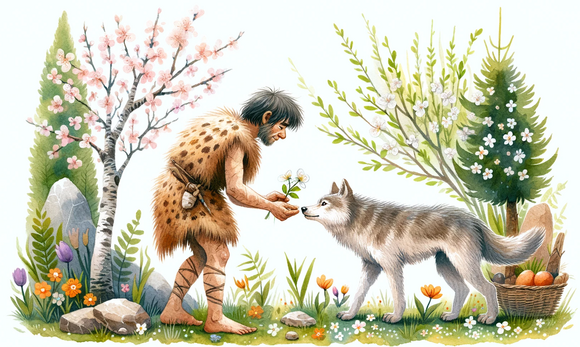A faithful companion through the ages: The fascinating history of the dog

Origins in the wild: The first canids
Our story begins around 40 million years ago, when the first canid-like animals, the ancestors of today's dogs, appeared on Earth. These early canids were small, marten-like creatures that lived in North America. Over time, these animals evolved into larger and more diverse species that spread across different continents.
The wolf enters the scene
Around one to two million years ago, the first wolves evolved. These large, intelligent predators were able to hunt in packs and adapt to a wide variety of environments. The gray wolf, the direct ancestor of today's domestic dog, spread across Eurasia and North America.
Man's best friend: Domestication
The domestication of dogs probably began around 15,000 to 30,000 years ago. Archaeological findings and genetic analyses indicate that humans began to raise and domesticate young wolves. These early dogs helped their human companions hunt and provided protection and companionship.
From wolf to working companion
Over time, the tamed wolves evolved into different types of dogs that were bred for specific tasks. Herding dogs, hunting dogs, sled dogs and guard dogs are just a few examples of how dogs have been used to make people's lives easier over the centuries.
Why are there so many different breeds of dogs?
The reason for the wide variety of dog breeds lies in targeted breeding by humans. Different breeds were developed by selecting certain characteristics and traits that were desired for specific tasks or aesthetic ideas. This process led to an impressive range of sizes, shapes and temperaments among the dogs we know today. From tiny Chihuahuas to mighty Mastiffs, from nimble Greyhounds to patient Labrador Retrievers, each breed was bred with a specific goal in mind.
Dogs in the ancient world: symbols of culture
In many ancient civilizations, dogs were highly valued and often even revered. In ancient Egypt, dogs were considered sacred animals and were often buried with their owners. In Greek mythology, dogs were depicted as companions of gods and heroes.
Faithful companions in art and literature
Dogs also have a firm place in art and literature. From the loyal hunting dogs in medieval paintings to the heroic stories of dogs saving their owners' lives, dogs have often been portrayed as symbols of loyalty, courage and love.
The modern dog: from the street to the living room
In the 19th century, people began to breed dogs not only for their usefulness, but also for their appearance and personality. This led to the creation of many of the dog breeds we know today. Dog shows and dog sports became popular and encouraged interest in purebred dogs.
The dog as a member of the family
Today, dogs are much more than just working or guard animals; they are fully-fledged family members. The relationship between humans and dogs has developed into a deep emotional bond characterized by mutual understanding and love.
Conclusion
The story of dogs is a remarkable journey from wild predators to beloved companions. It shows how deeply rooted the bond between humans and dogs is and how this relationship has continued to grow over time. Dogs are not only a mirror of human society, but also a living example of how a relationship of convenience and necessity can become one of unconditional love and deep trust. As we look into the eyes of our four-legged friends, we see not only a reflection of ourselves, but also the story of an age-old friendship that has endured through the ages.